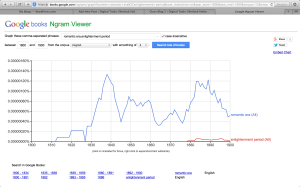Google Ngrams provided an interesting visualization when comparing the Romantic Era and Age of Enlightenment during the 19th century. When I first started typing in words into Ngram, it was very interesting to see how different ways you phrase a word can drastically change the graph. Based on this, I have come to realize that you have to be quite specific about what you want to search as simple additions, subtractions, and changes of word(s) can impact your graphical result. Also, adding “case-insensitive” changes the graph as well. In order for mine to make more sense, I added “case-insensitive” because when I didn’t have it, the Enlightenment line was all flat except for tiny spikes around 1880 and 1890.
On my graph, it makes sense that the Romantic Era spiked significantly between 1830 and 1850, and the Age of Enlightenment did not make any progress until the later part of the 1800s. The Romantic Era was a response to the Enlightenment Movement; it was a rebellion of sorts against scientific and logical thinking. So, it would make sense that the Romantic Era would be more popular then the Age of Enlightenment. The Enlightenment’s highlight was during the 18th century, and did not become revived again until around the 20th century. The Romantic Era touched many areas of life in the 19th century: art, architecture, music, and most importantly literature. Many famous Romantic authors and poets emerged throughout this time period and provided a huge influence and impact on the Romantic Era. Lord Byron, Samuel Taylor Coleridge, William Wordsworth, and John Keats were some of the most famous Romantic poets. Jane Austen and the Brontë sisters were other authors that came into popularity. These famous authors contributed so much to the Romantic Era, and as evident by the graph, helped it spike throughout the 19th century.
My second graph depicts the horse and buggy compared to the automobile. As the primary mode of transportation, the horse and buggy was what almost everyone drove during the beginning of the 19th century. Although it was used often, the horse and buggy was best suited for short distance. But the creation of the automobile changed that. In 1769 the first steam powered automobile was created by a man named Nicolas-Joseph Cugnot and in 1807 François Isaac de Rivaz designed the first car with an internal combustion engine powered by hydrogen. By 1886 the automobile was powered by petrol, or gasoline, curtesy of Karl Benz who called it the Benz Patent-Motorwagon. The first electrically powered car did not come around until the turn of the 20th century. The more popular the automobile became, the more people began to use it; so, as a result the horse and buggy went down in popularity while the automobile rose.
